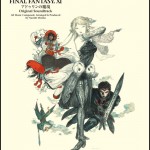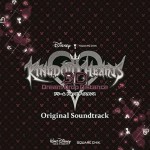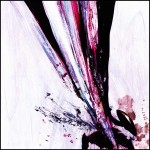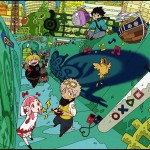As the 20th anniversary of the Seiken Densetsu series wraps up with the end of 2011, we now have in our hands both album releases intended to commemorate the occasion. We unboxed the massive Seiken Densetsu Music Complete Book, and now we have Kenji Ito’s arrange album, Re:Birth/Seiken Densetsu Kenji Ito Arrange Album.
While word has it that other arrange albums are on their way from other composers involved with the Seiken Densetsu franchise, we’ve been listening to Ito’s short but sweet album. Does it bring back fond memories of the series, and does Ito dazzle fans with his signature piano work?
Hit the jump for our review.
Although this album is dedicated to Kenji Ito’s work from the Seiken Densetsu series, over half of the album’s ten tracks are from Final Fantasy Adventure (the original Seiken Densetsu). I guess that makes sense given that his contributions to Dawn of Mana were already high in quality, and Children of Mana was the only other title in the series that he worked on.
The album covers a wide array of styles, but you probably guessed correctly that Ito’s signature piano work is featured prominently throughout. There are ballads, techno remixes, electronic and rock infused tracks, and even some rather exotic sounds featured. The Mana series to me has always had this soothing or calming connotation, so it’s interest to see Ito explore so many styles with this album.
Let’s start from the top with “Rising Sun” from Final Fantasy Adventure. This is truly one of the great themes in the world of videogames, so it’s a shame that it’s not heard more often. Ito captures that soothing essence I alluded to before with this beautiful piano ballad backed by string swells and well-placed orchestral percussion. It’s been 20 years since this title was released, and this kind of update is exactly what I had hoped for.
Other tracks from Final Fantasy Adventure include the heartbreaking “Mana’s Mission” with its somber piano melody backed by strings that drip with emotion. The highlight, however, is the female voice that calls out gently from the background, carrying parts of the melody. The final track on the album, “Legend Forever,” is yet another mellow track, turning the ending theme from the game into a sweet solo piano ballad that I could picture as a backdrop for an awesome Ken Hirai song. It’s an emotional closing piece for the album.
“Mana Palace” goes off in a different direction, retaining the dreamy ambiance of the previous tracks with lots of reverb, but working in electronic bass and some tasteful synth work that lead the way over Ito’s jazzy piano chords. “Final Battle” is one of the most drastic transformations on the album, taking the energetic battle theme and slowing it down to a contemplative ballad. The production on this track is top notch, the only thing missing are the vocals!
The most shocking track on the album is “In Search of the Sacred Sword” arranged by quad (luvtrax) rather than Ito himself. It’s an energetic trance remix of the already uplifting theme. As the second track on the album, coming immediately after “Rising Sun,” I couldn’t believe what I was hearing. The arrangement and production on this track is fantastic, although in terms of flow, I think it would have made a better bonus track or hidden track at the end of the album.
It’s then on to material not from Final Fantasy Adventure, which leaves only four tracks. “Battle 2 –Touched by Courage and Pride-” from the Sword of Mana stays true to the original, opening with a powerful string segment before launching into an acoustic guitar-driven rock track of sorts. “Infant of Mana” from Children of Mana really gets us rocking and rolling, however, with wailing electric guitar, organ, and harpsichord, coming as a rock opera of sorts not too unlike something I could imagine The Black Mages performing live. It’s certainly one of the best tracks on the album despite shattering that gentle image of the Mana series I generally hold.
There are two tracks featured from Dawn of Mana. Honestly, the original soundtrack featured some pretty high quality material, and the arrangements here don’t add a whole lot. “The Fool’s Dance” sports a Latin flair with acoustic guitar and traditional flamenco percussion, with the main addition over the original being the inclusion of a female vocalist who admittedly gives a great performance. “The Endless Dream” gets a similar treatment, staying true to the original’s piano and string ballad form and adding a female vocalist singing in Japanese. It’s a nice addition, and the piece features hints of “Rising Sun” which is a nice touch.
While I enjoyed this album, I found myself wanting more. It does cover 45 minutes of music over its ten tracks, but I can’t help but feel there could have been a lot more. In the past, I’ve generally jumped to Hiroki Kikuta and Yoko Shimomura when I’ve thought of the Mana series, but this really opened my eyes to what Kenji Ito did for the franchise, and I’m hoping that Kikuta and Shimomura get a chance to do something similar in the future.
In terms of packaging, I absolutely love the cover of this album, featuring a giant mana tree surrounded by a waterfall and a line of birds. The booklet contains liner notes, an interview with Ito, and more artwork and images of Ito working on the album. The disc itself features the same image as the cover, but with a metallic gold backing, which is quite beautiful to look at.
For fans of Kenji Ito and Final Fantasy Adventure, this album is for you. The Dawn of Mana tracks feel a bit unnecessary, although they’re a fine addition. It’s available from both CD Japan and Play-Asia if you’re interested. It will set you back about $30 USD.
What do you make of the length and eclectic style featured on this album? Would you like to have heard other tracks arranged, and are you looking forward to Kikuta and Shimomura’s albums?
Tags: Final Fantasy Adventure, Kenji Ito, Music Reviews, Reviews, Seiken Densetsu, Square Enix








































